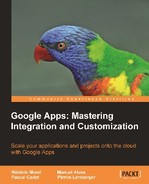Defining the scope of the pilot project, just as for any migration project, is essential. This scope should be representative of the actual target while only relying on a small sample of the population, a partial set of features and, most often, a technical environment that is not an exact copy of the target environment.
In the specific case of an experiment with the Google Apps, defining the scope means choosing:
- The set of Google Apps to experiment with, the most customary being Gmail and Google Calendar.
- The subset of representative users. These are sometimes called pilot users.
- The appropriate amount of training and support to provide to users to optimize their implication level.
Another important point is the context within which users are testing the Google Apps. For the result of the pilot project to be significant, using the Google Apps should happen in the most realistic way possible. In other words, pilot users should use their new tools on a daily basis to communicate and collaborate with their co-workers. Indeed, as experience shows, isolated experiments are seldom significant or useful. Using Google Apps "no matter what" should be the users' motto during the pilot phase, especially if the existing system remains active.
While selecting such tools as Gmail and Google Calendar is commonplace or even trivial, it is not so obvious to choose among the remaining items in the "galaxy" of Google Apps. Google Talk can be integrated as an instant messaging tool. If the experiment also involves collaboration, the candidate applications will be Google Document, Google Sites, and Google Video. Advanced integration with the existing environment can require using SSO services, Enterprise Search Appliance, or developing specific applications using Google APIs. Mobile usage, on the other hand, doesn't require much thought or testing, because the Google Apps platform is natively multichannel and continuously improving to address evolving mobility needs.
The most important questions, though, are related to the effort required to transfer data to the Google Apps. Here are three questions to ask for each application:
- Should all existing data be transferred?
- Should users have access to mail history and to existing calendar events so as to assess the features and possibilities of the Google Apps?
- Does the absence of such information as the postal address in the contacts prevent properly evaluating the solution?
These questions are meant as hints to simplify the pilot without penalizing the experimentation itself.

Apps that selected for integration in the pilot project
One key to a successful pilot is the choice of pilot users. Obviously, a good choice will be one which includes a representative sample of the whole target population. One can choose a user by subsidiary, by department, by business line, or by geographic area.
One other advantage of a diverse selection of users is that it allows testing collaborative aspects of the solution. One could select, for instance, users from various divisions in the company, working together on a project or accustomed to working together.
If, on the other hand, Google Apps is targeted at a specific population in the company, it is essential to have users from that population participating in the pilot. One such example is users who don't have any mail yet.
Beyond the criteria just mentioned, there are also criteria related to the experimental phase itself. For instance, it is certainly a good idea to include those users who already use Gmail for personal purposes. The support they will need will obviously be less than that required for novices.
The motivation of pilot users should also be taken into account. Rather than imposing a software change on some people selected without their knowledge, it might be a good idea to take a quick poll to see who is interested in the subject.
